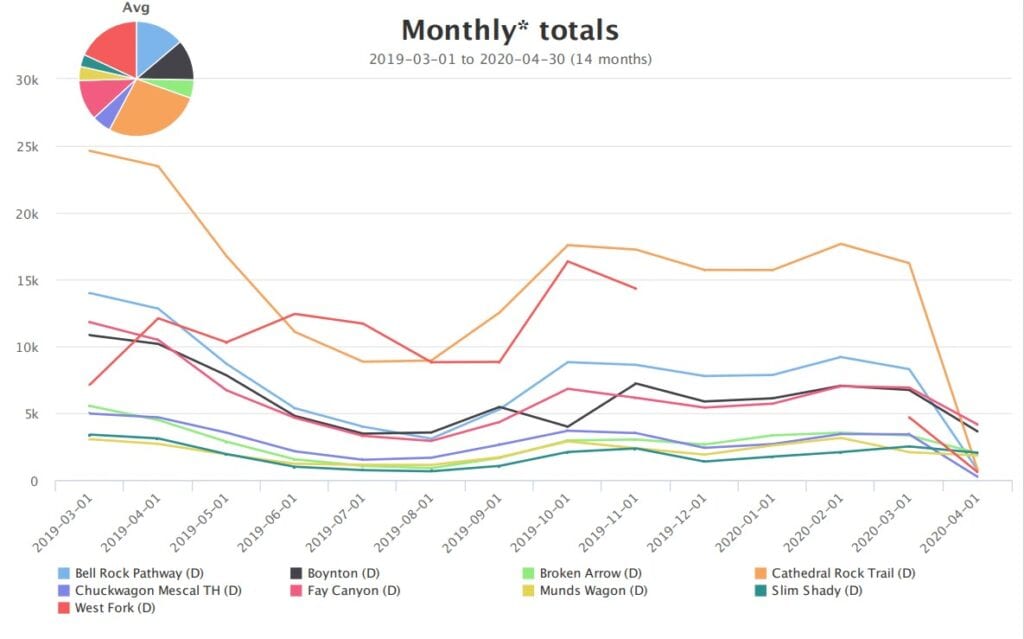If you go hiking in the Sedona area, don’t forget to smile. You may end up on the U.S. Forest Service’s version of a candid camera — a trail counter.
USFS personnel began installing trail counters on non-motorized trails around Sedona in February 2014. Eleven trails were eventually equipped with them, although the Bell Trail and Devil’s Bridge counters are not currently operable. Most of the counters are infrared, with the exception of one magnetic counter used to count bicycles.
The maintenance requirements for the counters are minimal, consisting of “new batteries and desiccant packs as needed, no more than twice a year,” Coconino National Forest public affairs officer Brady Smith said. “Data is downloaded from the counters on a recurring basis by our volunteers and uploaded into a data management website.”
The Forest Service does not share the locations of counters due to concerns over theft or vandalism. However, Smith added, “they are not concealed, but they are in locked metal containers bolted to wooden posts or trees.”
Count Off
The data collected by the counters not only shows that trail usage patterns have changed since the years prior to the COVID-19 pandemic response, but also indicates that overall trail use peaked in 2021 and has been in decline since then.

- Daily usage patterns for Bell Rock have remained consistent, ranging from 263 daily users in 2018 to 264 in 2021 and 276 so far in 2023.
- The Bell Trail saw a sharp dropoff in visitors following spring break 2021 that had not reversed before the counter failed in 2022. Average usage was 60 people per day in 2018 and 66 in 2019, rising to 156 in 2020 and falling to 21 in 2021.
- Boynton Trail usage has increased substantially, from averages of 205 and 199 people per day in 2019 and 2020 to 359 in 2022 and 366 so far in 2023.
- Broken Arrow Trail usage has been largely unchanged, from 98 people per day in 2018 to 97 in 2022 and 2023.
- Cathedral Rock has returned to prepandemic response levels. Average daily users rose from 406 in 2018 to peak at 592 in 2021 before declining to 464 in 2022 and 429 in 2023.
- Visitation has doubled on the Chuckwagon Trail, from 98 daily in 2019 and 82 in 2020 to 196 in 2022 and 208 in 2023.
- Fay Canyon has seen a small increase in use, from between 190 and 200 users each day from 2018 through 2020 to 264 in 2021 and 242 this year.
- Munds Wagon Trail use remained between 65 and 75 people per day on average from 2018 through 2022 and is currently at 107 for 2023.
- Slim Shady has also experienced a small increase, from 53 in 2018 to 63 in 2022.
- West Fork usage has steadily dropped from 334 people per day in 2018 to 298 in 2022 and 195 this year.
- Figures for recent Devil’s Bridge usage are incomplete, as the counter failed on March 26, 2021. Daily usage was 459 in 2018, 472 in 2019 and 529 in 2020. The number of daily users averaged 764 in 2021, which was based only on data from the first three months of the year, including the busiest season of spring break. The averages for the first 85 days of the preceding three years were 550, 487 and 606, or 13% higher than the annual average, which would put estimated daily visitation for Devil’s Bridge in 2021 at 665. During the first three years for which full data was available, Devil’s Bridge was responsible for 23% of all recorded trail usage.
The average daily number of trail users across all monitored trails was 1,934 in 2018, 2,313 in 2019, 2,405 in 2020, 2,941 in 2021, 2,054 in 2022 and 1,985 in 2023. Adjusting the last three numbers for omissions in the Devil’s Bridge data gives estimated daily usage of 2,842 for 2021, 2,719 for 2022 and 2,650 for 2023.
The total number of hikers counted on surveyed trails each year was:
- 686,062 in 2018
- 804,216 in 2019
- 832,193 in 2020
- 842,739 in 2021
- 744,556 in 2022
- 420,294 through July 2023
These counts overstate the number of trail users, as the counters do not distinguish between hikers going out and coming back who may pass a sensor twice on one-way trails.
Overall, trail usage rose 27% above 2019 levels by 2021, and, based on estimated usage for 2023, has now declined to 15% above 2019 levels. The cumulative number of trail users for the first seven months of 2023 was 9% below 2022 levels and 21% below 2021 levels.
Local Component
The Coconino National Forest’s 2020 visitor use survey found that 35.8% of forest visitors came from Yavapai County, 30.3% from Coconino County, 14.7% from a foreign country and 11.9% from Maricopa County. Locally, 13.5% are from Sedona and 9.2% from the Village of Oak Creek.
Based on these numbers, about 100,000 of the Forest Service’s recorded trail users in 2022 would have been Sedona locals, and roughly 68,000 would have been from the VOC.
Adjusting the 2022 user count to take the estimated number of Devil’s Bridge visitors into account, the 11 trails where usage is tracked by the Forest Service would have seen about 967,000 hikers in 2022, about 220,000 of whom would have been from Sedona and the VOC. Since the Sedona Chamber of Commerce’s most recent visitor survey found that 65% of visitors to Sedona go hiking, the remaining 747,000 hikers could have represented about 1.15 million total visitors.